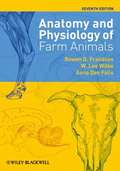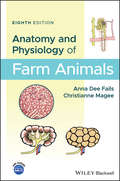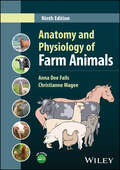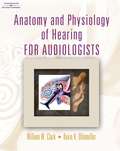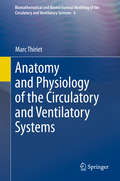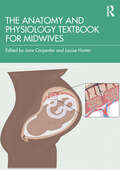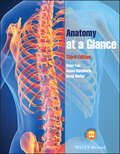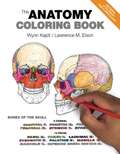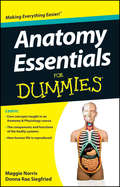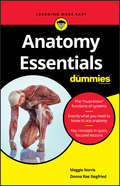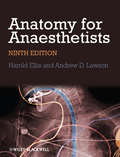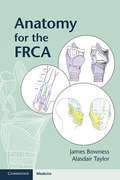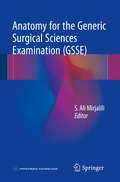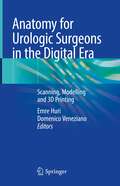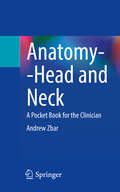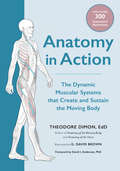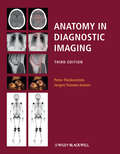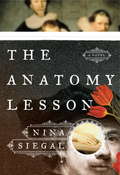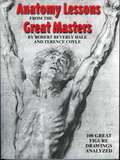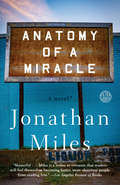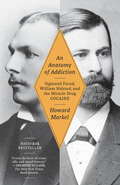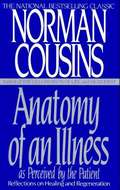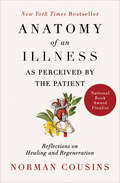- Table View
- List View
Anatomy and Physiology of Farm Animals
by Anna Dee Fails Rowen D. Frandson W. Lee WilkeThe Seventh Edition of Anatomy and Physiology of Farm Animals is a thoroughly updated and revised version of this classic text. Drawing on current science and terminology with a number of new illustrations throughout and a new chapter on poultry, the book maintains its reputation for clarity, balanced scope, and breadth of content. The Seventh Edition provides veterinary, animal science, agriculture, and veterinary technician students with a comprehensive yet clear reference to understanding the fundamentals of anatomy and physiology.
Anatomy and Physiology of Farm Animals
by Anna Dee Fails Christianne MageeRevised and updated, the eighth edition of Anatomy and Physiology of Farm Animals remains the essential resource for detailed information on farm animal anatomy and physiology. Offers a revised edition to this comprehensive guide to the anatomy and physiology of farm animals Presents learning objectives in each chapter for the first time Adds new material on endocrine and metabolic regulation of growth and body composition Features additional illustrations to enhance comprehension Includes a companion website that offers supplemental content, including word roots, clinical cases, study and practice questions, the images from the book and additional images, diagrams, and videos to enhance learning.
Anatomy and Physiology of Farm Animals
by Anna Dee Fails Christianne MageeA complete guide to the anatomy and physiology of farm animals, fully updated and revised In the newly revised ninth edition of Anatomy and Physiology of Farm Animals, distinguished veterinary professors Drs. Anna Fails and Christianne Magee deliver a comprehensive guide for animal science, veterinary technician, and pre-veterinary students and instructors seeking a well-organized and easy-to-understand resource. The new edition offers modified and refined learning objectives at the beginning of each chapter, as well as a brand-new chapter on llamas/alpacas that highlights the significant species differences and explains the roles of these species in the wool and packing industries. Additional illustrations enhance comprehension and improve the anatomy sections of the book. New “Study Prompts,” integrative application questions, are included in each chapter in differently colored text and stimulate understanding of the material. Finally, a reorganized companion website is included with the book. It integrates fully with the print text and provides supplemental content, including word roots, clinical cases, study and practice questions, and additional images, diagrams, and videos. Readers will also find: An excellent anatomy and physiology resource for high school and undergraduate students in animal science, veterinary medicine, and zoology programsComprehensive explorations of the anatomy and physiology of the cell Practical discussions of embryology, the skeletal system, and microscopic anatomy Complete discussion of the physiology of muscle and the anatomy and physiology of the nervous system A valuable comprehensive resource for advanced high school and undergraduate animal science students in agriculture, pre-veterinary, and veterinary technical program, Anatomy and Physiology of Farm Animals will also benefit people practicing in allied professions and veterinary practitioners.
Anatomy and Physiology of Hearing for Audiologists
by Kevin K. Ohlemiller William W. ClarkThe first anatomy and physiology text just for audiologists, this new text brings together some of the best professional minds in the field to consider the structures and mechanisms of the auditory system. <P><P>Basic science is covered in the foundations section of the text, giving a much needed examination of the biological processes in terms the audiologist needs most. <P><P>Detailed examination of the anatomy and physiology of hearing follows with diagrams and in-depth discussions. The text concludes with chapters on the pathology of hearing, covering the different causes of hearing loss, from noise-induced hearing loss to genetic aspects of hearing loss. <P><P>From start to finish this text is written specifically for the audiologist, making it an essential foundational resource.
Anatomy and Physiology of the Circulatory and Ventilatory Systems (Biomathematical and Biomechanical Modeling of the Circulatory and Ventilatory Systems #6)
by Marc ThirietTogether, the volumes in this series present all of the data needed at various length scales for a multidisciplinary approach to modeling and simulation of flows in the cardiovascular and ventilatory systems, especially multiscale modeling and coupled simulations. The cardiovascular and respiratory systems are tightly coupled, as their primary function is to supply oxygen to, and remove carbon dioxide from, the body's cells. Because physiological conduits have deformable and reactive walls, macroscopic flow behavior and prediction must be coupled to nano- and microscopic events in a corrector scheme of regulated mechanism. Therefore, investigation of flows of blood and air in physiological conduits requires an understanding of the biology, chemistry, and physics of these systems, together with the mathematical tools to describe their functioning in quantitative terms. The present volume focuses on macroscopic aspects of the cardiovascular and respiratory systems in normal conditions, i. e. , anatomy and physiology, as well as the acquisition and processing of medical images and physiological signals.
The Anatomy and Physiology Textbook for Midwives
by Jane Carpenter Louise HunterFocusing on optimising the normal biological processes of reproduction and early life, and in line with the Nursing and Midwifery Council (NMC) Future Midwives Standards, this comprehensive textbook introduces the fundamental anatomy and physiology knowledge needed for midwifery practice. This textbook follows the journey from preconception to the puerperium. Divided into six parts, it begins with foundational material before moving onto reproduction, embryology and fetal development. The central sections of the book consider maternal changes and adaptations during pregnancy, the intrapartum period, and the puerperium and transition from fetal to neonatal life. The book finishes with a section looking at lactation. Containing numerous full colour illustrations, each chapter includes 'Application to practice 'boxes, 'challenge' sections and 'interrupters' to help you consolidate your learning. The text is accompanied by a downloadable interactive workbook to complete as you read. Written in a clear and accessible style, The Anatomy and Physiology Textbook for Midwives is an essential read for preregistration midwifery students, studying at both BSc and MSc levels.
Anatomy at a Glance
by Omar Faiz Simon Blackburn David MoffatFollowing the familiar, easy-to-use at a Glance format, and in full-colour, this new edition provides an accessible introduction and revision aid for medical, nursing and all health sciences students. Thoroughly updated and now fully supported by a set of web-based flashcards, Anatomy at a Glance provides a user-friendly overview of anatomy to encapsulate all that the student needs to know. Anatomy at a Glance: Addresses the basic concepts of anatomy in an highly visual, easy-to-remember way Features two new chapters outlining anatomical terminology and basic embryology Includes more coverage of imaging techniques such as CT and MRI Offers free online flashcards for self-assessment and revision at www. wiley. com/go/anatomyataglance To find out more about the at a Glance series, please visit www. ataglanceseries. com
Anatomy Atlas and Interpretation of Spine Surgery
by Jian-Gang Shi Wen Yuan Jing-Chuan SunThis book accentuates the anatomies involved in spine surgery techniques, from the base of the skull down to the sacrum and the sacroiliac joint. It includes extensive illustrations that cover all major spine surgeries. It also discusses the instrumentations used with different operative approaches. The book features high-resolution pictures of operative dissection, cadaveric specimens, and intraoperative imaging that clearly illustrate the relevant anatomy of various spine surgery procedures, allowing surgeons to "reconstruct" a three-dimensional anatomical view when performing the surgery. As such, it is a valuable reference resource for spine surgeons.
The Anatomy Coloring Book
by Wynn Kapit Lawrence ElsonFor more than 35 years, The Anatomy Coloring Book has been the #1 best-selling human anatomy coloring book! <p><p>A useful tool for anyone with an interest in learning anatomical structures, this concisely written text features precise, extraordinary hand-drawn figures that were crafted especially for easy coloring and interactive study. Organized according to body systems, each of the 162 two-page spreads featured in this book includes an ingenious color-key system where anatomical terminology is linked to detailed illustrations of the structures of the body. When you color to learn with The Anatomy Coloring Book, you make visual associations with key terminology, and assimilate information while engaging in kinesthetic learning. Studying anatomy is made easy and fun! <p><p> The Fourth Edition features user-friendly two-page spreads with enlarged art, clearer, more concise text descriptions, and new boldface headings that make this classic coloring book accessible to a wider range of learners.
Anatomy Essentials For Dummies
by Maggie A. Norris Donna Rae SiegfriedThe core concepts you need to ace AnatomyPerfect for those just starting out or returning to Anatomy after some time away, Anatomy Essentials For Dummies focuses on core concepts taught (and tested on!) in a typical Anatomy course. From names and technical terms to how the body works, you'll skip the suffering and score high marks at exam time with the help of Anatomy Essentials For Dummies.Designed for students who want the key concepts and a few examples--without the review, ramp-up, and anecdotal content--Anatomy Essentials For Dummies is a perfect solution for exam-cramming, homework help, and reference.A useful and handy reference to the anatomy of the human bodyPerfect for a refresher or a quick referenceServes as an excellent review to score higher at exam timeIf you have some knowledge of anatomy and want to polish your skills, Anatomy Essentials For Dummies focuses on just the core concepts you need to understand this fascinating topic.
Anatomy Essentials For Dummies
by Maggie Norris Donna Rae SiegfriedAnatomy Essentials For Dummies (9781119590156) was previously published as Anatomy Essentials For Dummies (9781118184219). While this version features a new Dummies cover and design, the content is the same as the prior release and should not be considered a new or updated product. The core concepts you need to ace Anatomy Perfect for those just starting out or returning to Anatomy after some time away, Anatomy Essentials For Dummies focuses on core concepts taught (and tested on!) in a typical Anatomy course. From names and technical terms to how the body works, you'll skip the suffering and score high marks at exam time with the help of Anatomy Essentials For Dummies. Designed for students who want the key concepts and a few examples—without the review, ramp-up, and anecdotal content—Anatomy Essentials For Dummies is a perfect solution for exam-cramming, homework help, and reference. A useful and handy reference to the anatomy of the human body Perfect for a refresher or a quick reference Serves as an excellent review to score higher at exam time If you have some knowledge of anatomy and want to polish your skills, Anatomy Essentials For Dummies focuses on just the core concepts you need to understand this fascinating topic.
Anatomy for Anaesthetists
by Harold Ellis Andrew LawsonFirst published in 1963, Anatomy for Anaesthesists is the definitive anatomy text for anaesthetists in training and remains an invaluable reference for those in practice. The text explores in depth those areas of particular interest to anaesthetists: the respiratory pathway, the heart, the vertebral canal and its contents, the peripheral nerves, the autonomic nervous system, and the cranial nerves, and also includes sections on the anatomy of pain and other zones of anaesthetic interest.This new 9th edition has been fully revised and updated to incorporate developments in regional techniques and the increased use of ultrasound.
Anatomy for the FRCA
by James Bowness Alasdair TaylorAnatomy questions are asked in all parts of the FRCA examinations, and for many trainees it is a particularly daunting part of the exams. This important new book provides a comprehensive, exam-orientated clinical anatomy book for anaesthetists preparing for all parts of the FRCA. It covers all body regions, relating underlying anatomy to practical procedures and anatomical principles, spanning the breadth of the curriculum and comprising exam-style questions: a chapter of SAQ questions, one of OSCE stations, one of SOE questions and one of MCQs. The text is highly illustrated in full colour with ultrasound images, diagrams and photographs of cadaveric material and models. This is the first anatomy book specifically orientated for the FRCA exam, making it an essential resource for anaesthetists preparing for all parts of the FRCA examination.
Anatomy for the Generic Surgical Sciences Examination (GSSE)
by S. Ali MirjaliliThis book is designed for Generic Surgical Sciences Examination (GSSE). This collection of questions and answers as well as short notes is intended to assist junior doctors in successfully sitting the GSSE. The questions are specifically designed to highlight key surgical anatomy, and are supplemented by images that replicate "spot-test" type questions. Illustrations are used here to highlight particular anatomical relationships that are difficult to grasp. Beyond the GSSE, this resource will be invaluable for those undertaking study for specialty-specific anatomy examinations, or the anatomy component of the fellowship examination. <P><P> This is a "prep course" specifically designed for passing the Generic Surgical Science Examination required by the Royal Australasian College of Surgeons (RACS).
Anatomy for Urologic Surgeons in the Digital Era: Scanning, Modelling and 3D Printing
by Emre Huri Domenico VenezianoThis book provides a practical guide in the use of imaging and visualization technologies in urology. It details how output from diagnostic systems, can be represented through synthetic, virtual and augmented reality tools, such as holograms and three dimensional (3D) modelling and how they can improve everyday surgical procedures including laparoscopic, robotic-assisted, open, endoscopic along with the latest and most innovative approaches. Anatomy for Urologic Surgeons in the Digital Era: Scanning, Modelling and 3D Printing systematically reviews diagnostic imaging, visualization tools available in urology and is a valuable resource for all practicing and in-training urological surgeons.
Anatomy--Head and Neck: A Pocket Book for the Clinician
by Andrew ZbarThis book offers an easy-to-follow technique to better appreciate the anatomy of the head and neck providing a concise, accessible and well-illustrated pocketbook. It is aimed principally at undergraduate and postgraduate students of anatomy in a wide range of fields such as medicine, dentistry and the paramedical services that include physiotherapy, occupational therapy and the biological sciences. The book should prove useful for postgraduate trainees in general and specialist surgery, radiology and interventional and emergency medicine. Providing a style of teaching that is grounded in a clinical context, the book explains why the anatomy that has been learned actually matters. Relevant developmental and comparative anatomy is incorporated placing the subject in an historical context. The book is footnoted and includes pertinent references and multichoice questions at the end of each chapter. The anatomy conveyed is presented with simple line drawings designed to answer specific anatomical questions. Students are encouraged to reproduce these images with the view that if they can draw the anatomy of a region they will understand and remember it well. This book changes the way anatomy is taught using a short, practical guide to cover specific body regions.
Anatomy in Action: The Dynamic Muscular Systems that Create and Sustain the Moving Body
by Theodore DimonAn illustrated guide to the core design principles of the body&’s musculoskeletal system—for kinesiologists, movement therapists, yoga teachers, dancers, and bodyworkers of all kindsWhat does knowledge of anatomical structure have to do with preventing everyday muscular aches, pains, and injuries? According to Dr. Theodore Dimon, everything!Our bodies are designed to work holistically, supported by an intelligently organized system of muscles, bones, and connective tissue. So when we target problem spots by stretching, relaxing, or strengthening individual muscles, we bypass the dynamic, interconnected network that enables healthy functioning and injury prevention. Understanding how this system works in action is the key.In this groundbreaking guide, Dr. Dimon describes the basic principles that govern our bodies&’ musculoskeletal architecture and provides practical exercises to activate specific muscle groups and demonstrate our bodies&’ efficient holistic function. Readers will learn about dynamic design and the body in action, including: • How the musculoskeletal system works as a whole • The relationship between proprioception and muscle length • About maximizing spinal, shoulder, hip, arm, and leg stability and health • The important role of breath and breathing • About posture and musculoskeletal support With more than 300 illustrations, this is an ideal resource for students and practitioners of kinesiology, bodywork, movement, sport kinesiology, dance, and all readers searching for a dynamic guide to the human body.
Anatomy in Diagnostic Imaging
by J?rgen Tranum-Jensen Peter FleckensteinNow in its third edition, Anatomy in Diagnostic Imaging is an unrivalled atlas of anatomy applied to diagnostic imaging. The book covers the entire human body and employs all the imaging modalities used in clinical practice; x-ray, CT, MR, PET, ultrasound and scintigraphy. An introductory chapter explains succinctly the essentials of the imaging and examination techniques drawing on the latest technical developments.In view of the great strides that have been made in this area recently, all chapters have been thoroughly revised in this third edition. The book's original and didactically convincing presentation has been enhanced with over 250 new images. There are now more than 900 images, all carefully selected in order to be user-friendly and easy-to-read, due to their high quality and the comprehensive anatomical interpretation directly placed alongside every one.Both for medical students and practising doctors, Anatomy in Diagnostic Imaging, Third edition will serve as the go-to all-round reference collection linking anatomy and modern diagnostic imaging.
The Anatomy Lesson
by Nina SiegalSet in the Dutch Golden Age, an engrossing historical novel that brilliantly imagines the complex story behind one of Rembrandt's most famous paintingsCommissioned by the Amsterdam Surgeons' Guild, The Anatomy Lesson of Dr. Nicolaes Tulp was the first major Rembrandt work to catapult the young painter to international fame. Taking this painting as its inspiration, Nina Siegal's novel The Anatomy Lesson opens on the morning of the medical dissection and follows several characters as they prepare for the evening's big event: we meet Aris the Kid, a one-handed coat thief who is awaiting his turn at the gallows; Flora, the woman who is pregnant with his child and who hopes to save him from the executioner; Jan Fetchet, a curio collector who also moonlights as an acquirer of medical cadavers; René Descartes, who will attend the dissection in the course of his quest to understand where the human soul resides; and the twenty-six-year-old Dutch master himself, who feels a shade uneasy about this assignment. And in the twenty-first century, there is Pia, a contemporary art historian who is examining the painting. As the story builds to its dramatic and inevitable conclusion, the events that transpire throughout the day sway Rembrandt to make fundamental changes to his initial composition. Bringing to life the vivid world of Amsterdam in 1632, The Anatomy Lesson offers a rich slice of history and a textured story by a young master.
Anatomy Lessons from the Great Masters
by Robert Beverly Hale Terence CoyleThis classic book, whose foremost author was one of the great artistic anatomy teachers of the twentieth century, is an invaluable instructor and reference guide for any professional, amateur, or student artist who depicts the human form. Revealing the drawing principles behind one hundred inspiring masterpieces, the book presents work by Leonardo, Michelangelo, Rubens, Raphael, Titian, Rembrandt, and other greats.
Anatomy of a Miracle: A Novel*
by Jonathan Miles“A remarkable combination of medical mystery, satire and war story. Like Ben Fountain's Billy Lynn's Long Halftime Walk, it captures the long-lasting effects of war by focusing on those for whom war is only a tangential thing somewhere far away.” — Shelf Awareness"Miles's powerful prose nudges readers to seek the soft spots between faith and judgement, story and science, and fact and fiction." — CJ Lotz, Garden & GunA profound new novel about a paralyzed young man’s unexplainable recovery—a stunning exploration of faith, science, mystery, and the meaning of life Rendered paraplegic after a traumatic event four years ago, Cameron Harris has been living his new existence alongside his sister, Tanya, in their battered Biloxi, Mississippi neighborhood where only half the houses made it through Katrina. One stiflingly hot August afternoon, as Cameron sits waiting for Tanya during their daily run to the Biz-E-Bee convenience store, he suddenly and inexplicably rises up and out of his wheelchair. In the aftermath of this “miracle,” Cameron finds himself a celebrity at the center of a contentious debate about what’s taken place. And when scientists, journalists, and a Vatican investigator start digging, Cameron’s deepest secrets—the key to his injury, to his identity, and, in some eyes, to the nature of his recovery—become increasingly endangered. Was Cameron’s recovery a genuine miracle, or a medical breakthrough? And, finding himself transformed into a symbol, how can he hope to retain his humanity? Brilliantly written as closely observed journalistic reportage and filtered through a wide lens that encompasses the vibrant characters affected by Cameron’s story, Anatomy of a Miracle will be read, championed, and celebrated as a powerful story of our time, and the work of a true literary master.
An Anatomy of Addiction: Sigmund Freud, William Halsted, and the Miracle Drug Cocaine
by Howard MarkelFrom acclaimed medical historian Howard Markel, author of When Germs Travel, the astonishing account of the years-long cocaine use of Sigmund Freud, young, ambitious neurologist, and William Halsted, the equally young, pathfinding surgeon. Markel writes of the physical and emotional damage caused by the then-heralded wonder drug, and how each man ultimately changed the world in spite of it--or because of it. One became the father of psychoanalysis; the other, of modern surgery. Both men were practicing medicine at the same time in the 1880s: Freud at the Vienna General Hospital, Halsted at New York's Bellevue Hospital. Markel writes that Freud began to experiment with cocaine as a way of studying its therapeutic uses--as an antidote for the overprescribed morphine, which had made addicts of so many, and as a treatment for depression. Halsted, an acclaimed surgeon even then, was curious about cocaine's effectiveness as an anesthetic and injected the drug into his arm to prove his theory. Neither Freud nor Halsted, nor their colleagues, had any idea of the drug's potential to dominate and endanger their lives. Addiction as a bona fide medical diagnosis didn't even exist in the elite medical circles they inhabited. In An Anatomy of Addiction, Markel writes about the life and work of each man, showing how each came to know about cocaine; how Freud found that the drug cured his indigestion, dulled his aches, and relieved his depression. The author writes that Freud, after a few months of taking the magical drug, published a treatise on it, Über Coca, in which he described his "most gorgeous excitement." The paper marked a major shift in Freud's work: he turned from studying the anatomy of the brain to exploring the human psyche. Halsted, one of the most revered of American surgeons, became the head of surgery at the newly built Johns Hopkins Hospital and then professor of surgery, the hospital's most exalted position, committing himself repeatedly to Butler Hospital, an insane asylum, to withdraw from his out-of control cocaine use. Halsted invented modern surgery as we know it today: devising new ways to safely invade the body in search of cures and pioneering modern surgical techniques that controlled bleeding and promoted healing. He insisted on thorough hand washing, on scrub-downs and whites for doctors and nurses, on sterility in the operating room--even inventing the surgical glove, which he designed and had the Goodyear Rubber Company make for him--accomplishing all of this as he struggled to conquer his unyielding desire for cocaine. An Anatomy of Addiction tells the tragic and heroic story of each man, accidentally struck down in his prime by an insidious malady: tragic because of the time, relationships, and health cocaine forced each to squander; heroic in the intense battle each man waged to overcome his affliction as he conquered his own world with his visionary healing gifts. Here is the full story, long overlooked, told in its rich historical context.From the Hardcover edition.
Anatomy of an Epidemic: Magic Bullets, Psychiatric Drugs, and the Astonishing Rise of Mental Illness in America
by Robert WhitakerIn this astonishing and startling book, award-winning science and history writer Robert Whitaker investigates a medical mystery: Why has the number of disabled mentally ill in the United States tripled over the past two decades? Every day, 1,100 adults and children are added to the government disability rolls because they have become newly disabled by mental illness, with this epidemic spreading most rapidly among our nation’s children. What is going on?<P><P> Anatomy of an Epidemic challenges readers to think through that question themselves. First, Whitaker investigates what is known today about the biological causes of mental disorders. Do psychiatric medications fix “chemical imbalances” in the brain, or do they, in fact, create them? Researchers spent decades studying that question, and by the late 1980s, they had their answer. Readers will be startled—and dismayed—to discover what was reported in the scientific journals.<P> Then comes the scientific query at the heart of this book: During the past fifty years, when investigators looked at how psychiatric drugs affected long-term outcomes, what did they find? Did they discover that the drugs help people stay well? Function better? Enjoy good physical health? Or did they find that these medications, for some paradoxical reason, increase the likelihood that people will become chronically ill, less able to function well, more prone to physical illness? <P> This is the first book to look at the merits of psychiatric medications through the prism of long-term results. Are long-term recovery rates higher for medicated or unmedicated schizophrenia patients? Does taking an antidepressant decrease or increase the risk that a depressed person will become disabled by the disorder? Do bipolar patients fare better today than they did forty years ago, or much worse? When the National Institute of Mental Health (NIMH) studied the long-term outcomes of children with ADHD, did they determine that stimulants provide any benefit? <P> By the end of this review of the outcomes literature, readers are certain to have a haunting question of their own: Why have the results from these long-term studies—all of which point to the same startling conclusion—been kept from the public? <P> In this compelling history, Whitaker also tells the personal stories of children and adults swept up in this epidemic. Finally, he reports on innovative programs of psychiatric care in Europe and the United States that are producing good long-term outcomes. Our nation has been hit by an epidemic of disabling mental illness, and yet, as Anatomy of an Epidemic reveals, the medical blueprints for curbing that epidemic have already been drawn up.
Anatomy of an Illness as Perceived by the Patient: Reflections on Healing and Regeneration
by Norman CousinsAnatomy of an Illness is the story of Norman Cousins and his successful fight against a crippling disease. It is the story of a partnership between a physician and a patient in beating back the odds. The doctor's genius lay in helping the patient use his own powers -- laughter, courage and tenacity. The patient's talent was in mobilizing his body's own natural healing resources -- in proving what powerful weapons all the positive emotions can be in the war against disease.
Anatomy of an Illness as Perceived by the Patient: Reflections on Healing and Regeneration
by Norman CousinsNational Book Award Finalist: The &“amazing&” New York Times bestseller about the power of laughter and optimism in fighting serious illness (Chicago Sun-Times). Norman Cousins&’s iconic firsthand account of victory against terminal disease, Anatomy of an Illness as Perceived by the Patient inspired a revolution, encouraging patients to take charge of their own treatment. A political journalist and activist, Cousins was also a professor of medical humanities at UCLA, where he studied the biochemistry of human emotions and their relationship to healing. When Cousins was hospitalized with a debilitating collagen illness, he decided to take his health into his own hands. Cousins and his doctor combated the disease together by creating a regimen of laughter and vitamin C specifically calibrated to his needs. Against all odds, the treatment worked, proving to Cousins that a positive attitude was key to his improvement. Years later, Cousins set pen to paper to tell the story of his recovery. In this humorous and insightful account, Cousins analyzes his own journey in relation to holistic medicine and discusses the astounding power of mind over body. The result is an inspirational and educational guide to health that continues to offer hope to many. This ebook features an extended biography of Norman Cousins by his daughter, Sarah Cousins Shapiro.
